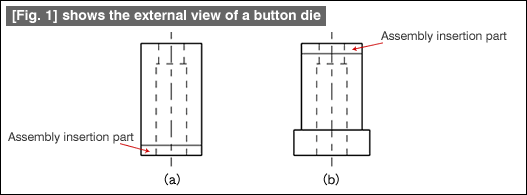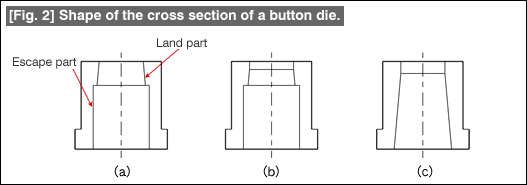#070 Method of Using Standard Components (19) Button Die - 1
A button die is used as a part inserted in a die plate (nested). It is used as an insert in a non-tempered die plate, and is used to make the preparation of the die easy, or to make the die maintenance easy, or to obtain a long life.
Fig. 1 shows the external view of a button die.

Straight type (a) is one that is used by lightly pressing inside the plate. An assembly insertion part has been provided in the part thereby making its assembly easy.
The type (b) is one with a flange. This shape can be said to be the standard type. The materials available for button dies are SKD11, SKH51, powder high speed steel, ultra hard alloys, etc.
Fig. 2 shows the cross section of the hole of a button die.

The hole is constituted from a land part (cutting edge part) and an escape part. There are three basic types of the hole cross sections as shown in the figure.
(a) is a type with a land part having a taper. This is a shape considering the passage of the blanked material. The drawback is that the hole becomes slightly larger every time the die is re-ground.
(b) is a type considering the drawback of the type (a), and the part necessary for regrinding has been made straight, and this is the type in which there is no change in the hole dimensions due to regrinding.
(c) is a type in which the part below the land part is not made to escape in a big way, and that part is escaped entirely by a taper. This is used relatively frequently for small diameter holes. This can be said to be a type in which some considerations have been given to scrap clogging. This is also called an angular button die.
Fig. 3 shows the types of cutting edge shapes that are being provided as standard parts.

Since the orientation of the hole is present in the types (b) to (d), there is no need for a rotation stopper. It is possible to specify in detail the different dimensions, the method of preparing the rotation stopper, etc. It is also possible to make changes in the details related to the cross section, and it is possible to make the shape most suitable for the pressed material and the plate thickness.
Punches and button dies have been standardized and made available at low costs, and hence it can be said that die preparation has become quite easy. Punches and button dies can be said to be parts in which the effect of standardization has been brought out in a big way.
- #167 Problems in Punching and their Countermeasures (6) Scrap Processing in Punching
- #166 Problems in Punching and their Countermeasures (5) Trimming of Drawn and Shaped Parts
- #165 Problems in Punching and their Countermeasures (4) Scrap Clogging in Punching
- #164 Problems in Punching and their Countermeasures (3) Bending and Twisting of Narrow Punched Parts
- #163 Problems in Punching and their Countermeasures (2) Bending due to Punching



